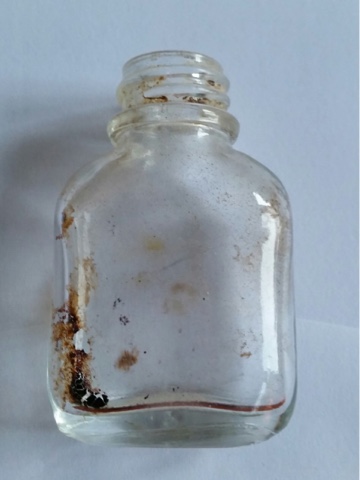Sepia and family history are distinctly lacking in my post this week, but just for fun here are a few family photos prompted by the image in the card. I thought firstly of the following shots I remembered of one of our boys in about 1990, sleuthing around the house looking for who knows what. I don't think he was dressed up for Halłoween, but he does look a bit like the gentleman in the mirror.
Then here is our older daughter a few years later in 1995, looking very grown up as she makes herself beautiful in front of her bedroom mirror, getting ready for her Year 10 formal.
Halloween wasn't much celebrated when our children were small. Jumping back 10 years from 1995, here is a photograph of this good witch cake that I made once, not for Halloween but for the above daughter's 5th birthday in February 1985, when we took her and seven young friends to watch a play entitled "Ballads and Bushy Tales", written by Audrey Blaxland and and performed by the local Marian Street Theatre for Young People, of which Ms Blaxland was the founder. Amazingly I've even noted the names of all the party guests in my photo album. The play sounds typically Australian, nothing to do with witches, although it might have involved a mythical creature or two, such as a bunyip perhaps. If you don't know what a bunyip is, you can see a statue of one here in an earlier blog of mine. There could be a few of them lurking about on Halloween night. Our other daughter actually lives near a town called Bunyip, but I don't think there are any out there.
Halloween has become more widely recognised here in recent years thanks to commercial influence, but it's not part of the Australian culture and is still not celebrated by the majority of Australians. In our local area these days groups of children do dress up and go out wandering, with the younger ones accompanied by parents hovering in the background. If we are happy to welcome them, we can put a pumpkin or similar symbol on the gate, but if not we won't be bothered by them. Here in Victoria an 'unofficial' long weekend is coming up, as we get a holiday on the following Tuesday for running of the Melbourne Cup, commonly known as 'the race that stops a nation', and always held on the first Tuesday in November. People who aren't interested in dressing up for either racing or Halloween often take the Monday off and go away somewhere for a short break. We won't be taking the day off this year, but on Saturday we may drive out to a folk festival that is held annually in the town of Maldon.
Finally, here's a photo taken by our first daughter, showing her little Londoner last year, dressed up in a cat costume and surrounded by pumpkins for a Halloween party organised by her mother and friends. Their babies all looked very cute in their outfits but must have wondered what on earth it was all about! We are greatly looking forward to seeing Isabelle and family down here for her uncle the sleuth's wedding very soon now. I guess he eventually found what he was looking for, and we will definitely all be dressed up for that happy occasion!
Happy Halloween to those who celebrate it, and to any Australians and others interested in horse racing, good luck in the Melbourne Cup!
For more memories and reflections about Halloween, sleuths, mirrors, beautiful girls etc, go to





































